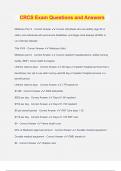SOLUTIONS MANUAL FOR
Income Tax Fundamentals 2023, 41e Gerald Whittenburg, Steven Gill
QUESTIONS AND PROBLEMS
, CHAPTER 1
THE INDIVIDUAL INCOME TAX RETURN
Group 1 – Multiple Choice Questions
1. D The income tax includes elements of social 20. C Surviving spouse is preferred to head of
and economic policy (LO 1.1) household (LO 1.5)
2. C The income tax was authorized by the 16th 21. E Either Margaret or her sister (but not both)
Amendment in 1913 (LO 1.1) may claim the mother as a dependent under
3. C The 1040A and 1040-EZ no longer exist and a multiple support agreement (LO 1.6)
the 1120 is for corporations (LO 1.2) 22. D The daughter fails the age test to be a
4. D Partnerships use Form 1065 to report qualifying child and she fails the gross
income tax information. A partner will income test ($4,400 in 2022) to be a
report their share of income from a part- qualifying relative (LO 1.6)
nership on a Form1040 (LO 1.2) 23. D The child tax credit in 2022 is $2,000
5. D Capital gains and losses are reported (LO 1.6)
directly on the face of the Form 1040 24. B The child tax credit for the 13-year-old child
(from Schedule D) (LO 1.2) is $2,000. The mother does not meet the
6. D A partnership is not generally a tax-paying support test and cannot be claimed (LO 1.6)
entity (LO 1.2) 25. B Must be age 16 or under for child tax credit
7. C Student loan interest is a for AGI deduction. (LO 1.6)
The other responses are all itemized (from 26. A Head of household standard deduction plus
AGI) deductions (LO 1.3) additional standard deduction for age 65
8. B The deduction for IRA contributions is a ($19,400 + $1,750) (LO 1.7)
for AGI deduction (LO 1.3) 27. B Taxpayers age 65 or older are eligible
9. D $98,000 – $13,000 (standard deduction is for an additional standard deduction
less than itemized deductions) (LO 1.3) amount (LO 1.7)
10. D For AGI adjustments are deducted to get 28. B Taxpayers that are blind are eligible for
to AGI (LO 1.3) an additional standard deduction amount
11. B The larger of the two may be deducted (LO 1.7)
(LO 1.3) 29. D Earned income plus $400 (LO 1.7)
12. A An exclusion reduces gross income (LO 1.3) 30. E Standard deduction may not exceed typical
13. B Filing thresholds generally are the same as amount (LO 1.7)
the standard deduction amount (LO 1.4) 31. D Business inventory is not considered a
14. D Ben’s income would need to exceed the capital asset (LO 1.8)
standard deduction to require filing a tax 32. A Gain of $15,000 ($25,000 amount realized
return (LO 1.4) less $10,000 adjusted basis) has been held
15. D $25,900 + $1,400 (LO 1.4) for more than 12 months and is long-term
(LO 1.8)
16. C Single dependent over 65 and blind thresh-
old is $4,500 for unearned income (LO 1.4) 33. C $10,000 = $240,000 – ($270,000 – $40,000)
(LO 1.8)
17. C Joan qualifies as either single or head of
household; however, head of household 34. A $43,000 – $3,000. Net capital losses of up
is more advantageous (LO 1.5) to $3,000 may be deducted from ordinary
income for individual taxpayers (LO 1.8)
18. D Although Dorothy does not live with
Glenda, since Dorothy is a parent that 35. C Line 7 is capital gain or (loss) (LO 1.9)
Glenda supports, Glenda may file as head 36. B Preparers must get a signed authorization to
of household (LO 1.5) e-file from the taxpayer. (LO 1.10)
19. D Taxpayer may file married filing jointly in 37. B About 90% of returns are filed electronically
year of spouse’s death (LO 1.5) (LO 1.10)
1-1
,1-2 Chapter 1 – The Individual Income Tax Return
Group 2 – Problems
1. a. Raising revenue to operate the government.
b. Furthering economic goals such as reducing unemployment.
c. Furthering social goals such as encouraging contributions to charities. (LO 1.1)
2. a. Form 1040
b. Schedule B
c. Schedule D
d. Schedule A
e. Schedule 2
f. Schedule E
g. Schedule 3
h. Schedule C
i. Schedule 1 (LO 1.2)
3. a. $36,300 = $42,000 + $300 – $6,000.
b. $25,900, the greater of itemized deductions or the standard deduction of $25,900.
c. $10,400 = $36,300 – $25,900. (LO 1.3)
4. a. $25,000.
b. $12,950, the greater of total itemized deductions or the standard deduction amount.
c. $12,050 = $25,000 – $12,950. (LO 1.3)
5. a. $53,800 = $54,000 + $2,800 – $3,000 ($7,000 capital loss limited to $3,000).
b. $12,950
c. $40,850 = $53,800 – $12,950. (LO 1.3 and 1.8)
6. a. $47,500 = $48,000 + $2,500 – $3,000.
b. $25,900, the greater of itemized deductions or the standard deduction of $25,900.
c. $21,600 = $47,500 – $25,900.
d. $2,184 (Tax Table) (LO 1.3, 1.5, and 1.7)
7. Adjusted gross income $18,000
Less: Itemized deductions –2,400
Taxable income $15,600
Marco’s tax liability from the Tax Table is $1,670. Note: because they are married and filing separately and Mar-
co’s spouse Tatiana itemizes her deductions, Marco must also itemize his deductions, even though the itemized
deductions total is less than the standard deduction he would be otherwise entitled to. (LO 1.3, 1.5, and 1.7)
8. Adjusted gross income ($13,200 + $1,450) $ 14,650
Less: Standard deduction –12,950
Taxable income $ 1,700
(LO 1.3, 1.5, and 1.7)
(Note: See Chapter 6 for the tax credit computation for dependent college students under age 24.)
9. a. $34,050 = $47,000 – $12,950.
b. Tax tables. Taxpayers with income up to $100,000 must use the tax tables.
c. $3,884. (LO 1.3, 1.5, and 1.7)
10. a. $66,000 = $50,000 + $8,000 + $5,000 + $3,000.
b. $63,500 = $66,000 – $2,500.
c. $27,000, the greater of itemized deductions or the standard deduction of $25,900.
d. $36,500 = $63,500 – $27,000.
e. $3,972 (LO 1.3, 1.5, and 1.7)
, Solutions for Questions and Problems – Chapter 1 1-3
11. a. $89,400 = $85,400 + $4,000.
b. $0.
c. $63,500 = $89,400 – $25,900 (standard deduction). (LO 1.3, 1.5, 1.6, and 1.7)
12. Taxable income is: $28,050 = $41,000 – $12,950. Tax liability from the tax tables not the tax rate schedules:
$3,164. (LO 1.3, 1.5, and 1.7)
13. Yes. Since Griffin owes Social Security taxes on the unreported tips (greater than $400), he must file an
income tax return. (LO 1.4)
14. a. No. Income is less than the $19,400 standard deduction. Although not required to file, Helen is likely
to be eligible for refundable credits and should.
b. Yes. Unearned income was more than $1,150. Also, gross income is more than the larger of $1,150
or $1,950 (earned income of $1,550 plus $400).
c. No. Their income is under the $27,300 standard deduction [$25,900 + $1,400 (over 65 years old)].
d. Yes. Gross income is greater than $25,900, the 2022 standard deduction.
e. Yes. His earnings exceeded the $400 limit for self-employed persons.
(Note: All answers can be found in the figures in LO 1.4.)
15. a. Allen $2,396. $34,600 – $12,950 = $21,650
b. Boyd $2,702. $37,175 – $12,950 = $24,225
c. Caldwell $4,008. $62,710 – $25,900 = $36,810
d. Dell $3,322. $49,513 – $19,400 = $30,113
e. Evans $5,391. $57,397 – $12,950 = $44,447 (LO 1.5)
16. a. D The mother is a qualifying person for head of household.
b. A The significant other is not a qualifying person as this individual is not one of the relatives
that can be considered a qualifying person for head of household.
c. A The brother does not qualify as a dependent (support test).
d. B or C MFJ can be claimed in the year of the spouse’s death and is probably preferable.
e. A, D or E. Surviving spouse is likely to be preferable but single or head of household are also possible.
(LO 1.5 and 1.6)
17. a. Because their income exceeds $100,000, the tax rate schedules must be used.
b. $14,554 = $9,615 + 22% x ($106,000 – $83,550). (LO 1.5)
18. Jonas could qualify as either a qualifying child or qualifying relative. The qualifying child tests should be
applied first:
1. Relationship test: Confirm Jonas’ relationship to Karl.
2. Domicile test: Where did Jonas live during the tax year? Was it more than one-half of the year with Karl?
3. Age test: What is Jonas’ age and is he a full-time student?
4. Joint return test: What type of tax return does Jonas file (if any)? If MFJ, is this only to obtain a refund?
5. Citizenship test: Is Jonas a US citizen or a tax resident of the US, Canada, or Mexico?
6. Support test: How much of Jonas’ support is provided by Jonas? Is it more than one-half?
If Jonas is a qualifying child, then he need not meet the citizenship test to be a qualifying person for head
of household filing status. If Jonas is not a qualifying child, he might be a qualifying relative which would
prompt the following questions:
1. Relationship or member of household test: If Jonas is Karl’s brother, this test has been confirmed in the
qualifying child questions. If Jonas is not one of the qualifying relatives, the remaining tests need not
apply since a person that is a qualifying relative by living in the taxpayer’s household is not a qualifying
person for purpose of the head of household test.





